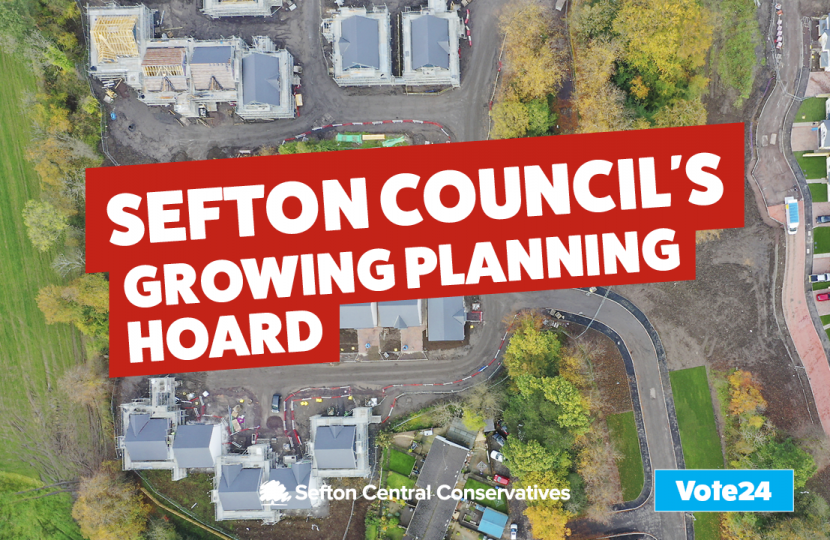
We have written previously about the way in which Sefton Council receives funding from housing developers but continually fails to spend the money on our local environment. Recent figures published by Sefton’s Labour Council show how that income is growing, but is not being spent in our local communities.
Sefton Council, as Planning Authority, is entitled to negotiate agreements for certain large-scale developments, especially new housing, under what are termed Section 106 Agreements.
Planning Obligations (also known as S106 Agreements) are legal agreements which can be attached to a planning permission to offset the impact of the development on the local environment, including loss of green space, additional school provision or road improvements. The intention is to lessen the impact of the development on the local community, making it more acceptable and enhancing the locality.
S106 Agreements can only be sought where they are directly related to the development, fairly and reasonably related in scale and kind to the development, and necessary to make the development acceptable in planning terms.
S106 contributions can either be provided on-site, for example through the provision of affordable housing, or off-site in the form of financial payments.
The value of these contributions can be appreciable. For example, in the current housing development of 183 houses on former agricultural land at Runnels Lane, Thornton, the Council obtained £2,129 for each dwelling to contribute towards primary school improvements in the locality. They also obtained over £100,000 for a new roundabout on Lydiate Lane, £10,000 for improvements around Buckley Hill and almost £89,000 for the provision of open space.
The new housing development on council-owned land at Holgate, Thornton, includes a contribution from the developer of £459,380 towards primary education in the Thornton/Crosby area, but the precise schools to benefit are not nominated.
Likewise, the proposed development of the Lydiate Lane site for 268 houses will also generate over £100,000 towards the new Lydiate Lane roundabout and £2,219 per dwelling for primary school improvements.
The Council is obliged to prepare an Annual Infrastructure Funding Statement showing how much has been obtained from developments and how much has been spent.
Sefton Council has just released their report for 2022/23 which contains several interesting facts and figures.
During 2022/23 the Council signed agreements which, if realised, would provide £2.3m of funding. They tell us that this would be spent on a range of infrastructure projects, including primary education, affordable housing, highways improvements and mitigation measures to offset visitor impact on the coast. Regrettably there is no detail to describe these intended projects.
It is hardly surprising that this Labour Council is so keen to encourage large-scale housing development on its precious agricultural sites, when these developments act as a very lucrative cash-cow for the council.
The actual sum received by the Council during 2022/23 was £1,868,352 towards local infrastructure.
By comparison the sum received in 2021/22 was £1,699,542 and in 2020/21 was a modest £365,314.
Whilst the money has been flowing in, it has not been spent by the Council and the sums held in reserves are growing.
The Council tells us that it currently retains £3,461,957 of Section 106 monies received prior to 2022/23 for local infrastructure. Whilst not allocated to specific projects, this money is required to be spent in accordance with the type of infrastructure and location as specified in the Section 106 agreement (e.g. primary education in the Maghull area). This Council’s Planning Committee however, recently refused the Council’s own application for an extension to the local primary school and it is therefore difficult to see how this issue will be addressed.
This retained sum of money has grown since 2021/22 when the Council was holding £1,767,353 in unexpended funds.
On a positive note, the Council reports that it spent £990,961 of its windfall S106 funding during 2022/23 on trees, greenspace and other local environmental improvements, as well as improvements to highways infrastructure and extending a local school. It is disappointing that as local residents we are not informed of the Wards or projects on which this money has been spent.
This again highlights the lack of transparency within which this Labour Council operates.
The Council has also disclosed that it is using £42,766 of its S106 funding on staffing costs for “monitoring the delivery of S106 obligations.” Last year this figure was just £8,014.
It is alarming that the Council is sitting on a growing treasure trove of over £3.461m of funding from previous years which should be used to benefit the local community. However, we are not informed of where, or when, this funding is to be allocated.
The Council’s own figures demonstrate that even when it is provided with appreciable funds to help improve the environment this Labour Council is unable to spend that money on the communities which are most affected by the developments.
Ask your local Councillor how much S106 money has been spent in your Ward and on what projects. We know that the new housing projects in Formby, Maghull and Thornton will create massive pressures on the highway and sewerage network, so what is the Council doing to address these fundamental issues in your locality?
Details of the Council’s Annual Infrastructure Funding Statement can be found at: https://modgov.sefton.gov.uk/mgIssueHistoryHome.aspx?IId=73797

